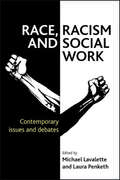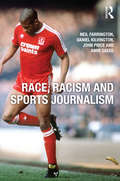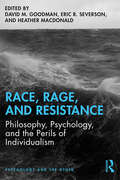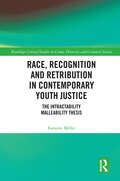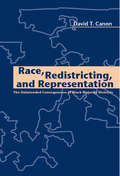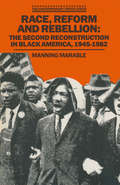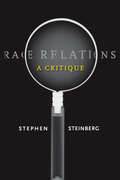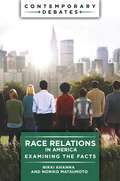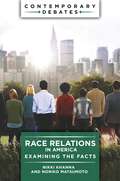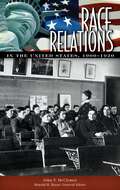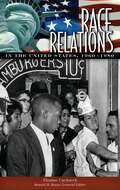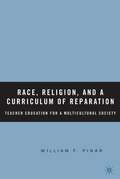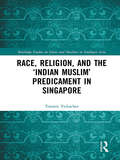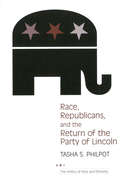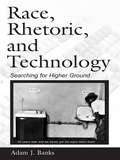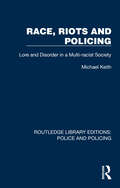- Table View
- List View
Race, Racism and Social Work: Contemporary issues and debates
by Michael Lavalette Laura PenkethWithout a doubt, structural and institutionalised racism is still present in Britain and Europe, a factor that social work education and training has been slow to acknowledge. In this timely new book, Lavalette and Penketh reveal that racism towards Britain’s minority ethnic groups has undergone a process of change. They affirm the importance of social work to address issues of ‘race’ and racism in education and training by presenting a critical review of a this demanding aspect of social work practice. Original in its approach, and with diverse perspectives from key practitioners in the field, the authors examine contemporary anti-racism, including racism towards Eastern European migrants, Roma people and asylum seekers. It also considers the implications of contemporary racism for current practice. This is essential reading for anyone academically or professionally interested in social work, and the developments in this field of study post 9/11.
Race, Racism and Sports Journalism
by Neil Farrington Daniel Kilvington John Price Amir SaeedBeginning with a theoretical discussion of race, sport and media, this book critically examines issues of race, racism and sports journalism and offers practical advice on sports reporting, including a discussion of guidelines for ethical journalism. In a series of case studies, representations of race will be explored through historical and contemporary analysis of international media coverage, including online and digital platforms. The background and impacts of these representations will also be discussed through interviews with athletes and sports journalists. Subjects covered include: cricket in the UK, Australian and Asian media, with particular focus on Pakistan athletics and media representations of athletes, including a study of the reporting of South African runner Caster Semenya football and the under-representation of British-Asians, with an analysis of how race is constructed in the digital arena boxing with particular reference to Muhammad Ali, America and Islam Formula One and analysis of the media reporting, international spectator response and racism towards Lewis Hamilton, described in the media as the first black driver. Finally, the book will analyse the make-up of sports journalism, examining the causes and consequences of a lack of diversity within the profession.
Race, Racism and Sports Journalism
by Neil Farrington Daniel Kilvington John Price Amir SaeedBeginning with a theoretical discussion of race, sport and media, this book critically examines issues of race, racism and sports journalism and offers practical advice on sports reporting, including a discussion of guidelines for ethical journalism. In a series of case studies, representations of race will be explored through historical and contemporary analysis of international media coverage, including online and digital platforms. The background and impacts of these representations will also be discussed through interviews with athletes and sports journalists. Subjects covered include: cricket in the UK, Australian and Asian media, with particular focus on Pakistan athletics and media representations of athletes, including a study of the reporting of South African runner Caster Semenya football and the under-representation of British-Asians, with an analysis of how race is constructed in the digital arena boxing with particular reference to Muhammad Ali, America and Islam Formula One and analysis of the media reporting, international spectator response and racism towards Lewis Hamilton, described in the media as the first black driver. Finally, the book will analyse the make-up of sports journalism, examining the causes and consequences of a lack of diversity within the profession.
Race, Rage, and Resistance: Philosophy, Psychology, and the Perils of Individualism (Psychology and the Other)
by David M. Goodman Eric R. Severson Heather MacdonaldThis timely collection asks the reader to consider how society’s modern notion of humans as rational, isolated individuals has contributed to psychological and social problems and oppressive power structures. Experts from a range of disciplines offer a complex understanding of how humans are shaped by history, tradition, and institutions. Drawing upon the work of Lacan, Fanon, and Foucault, this text examines cultural memory, modern ideas of race and gender, the roles of symbolism and mythology, and neoliberalism’s impact on psychology. Through clinical vignettes and suggested applications, it demonstrates significant alternatives to the isolated individualism of Western philosophy and psychology. This interdisciplinary volume is essential reading for clinicians and anyone looking to augment their understanding of how human beings are shaped by the societies they inhabit.
Race, Rage, and Resistance: Philosophy, Psychology, and the Perils of Individualism (Psychology and the Other)
by David M. Goodman Eric R. Severson Heather MacdonaldThis timely collection asks the reader to consider how society’s modern notion of humans as rational, isolated individuals has contributed to psychological and social problems and oppressive power structures. Experts from a range of disciplines offer a complex understanding of how humans are shaped by history, tradition, and institutions. Drawing upon the work of Lacan, Fanon, and Foucault, this text examines cultural memory, modern ideas of race and gender, the roles of symbolism and mythology, and neoliberalism’s impact on psychology. Through clinical vignettes and suggested applications, it demonstrates significant alternatives to the isolated individualism of Western philosophy and psychology. This interdisciplinary volume is essential reading for clinicians and anyone looking to augment their understanding of how human beings are shaped by the societies they inhabit.
Race, Ralph Ellison and American Cold War Intellectual Culture (Language, Discourse, Society)
by R. PurcellWhile the arms race of the post-war period has been widely discussed, Purcell explores the under-acknowledged but critical role another kind of 'race' – that is, race as a biological and sociological concept – played within the global and cultural Cold War.
Race, Recognition and Retribution in Contemporary Youth Justice: The Intractability Malleability Thesis
by Esmorie MillerRace, Recognition and Retribution in Contemporary Youth Justice provides a cross-national, sociohistorical investigation of the legacy of racial discrimination, which informs contemporary youth justice practice, in Canada and England. The book links racial disparities in youth justice, especially exclusion from ideologies of care and notions of future citizenship, with historical practices of exclusion. Despite the logic of care, found in both rehabilitative and retributive forms of youth justice, Black inner-city youth remain excluded from lenience and social welfare considerations. This exclusion reflects a historical legacy of racial discrimination apparent in the harsher sanctions levied against Black, innercity youth. In exploring race’s role in this arrangement, the book asks: To what extent were Black youth excluded from historic considerations of the lenience and social care, built into the logic of youth justice in England and Canada? To what extent are the disproportionately high incarceration rates, for Black, inner-city youth in the contemporary system, a reflection of a historic exclusion from considerations of lenience and social care? How might contemporary justice efforts be reoriented to explicitly prioritize considerations of lenience and social care ahead of penalty for Black, inner-city youth? Examining the entrenched structural continuities of racial discrimination, the book draws on archival and interview data, with interviewees including professionals who work with inner-city youth. In concert with the archival and interview data, the book offers the Intractability, Malleability I/M thesis, an integrated social theoretical logic with the capacity to expand the customary analytical scope for understanding the contemporary entrenched normalization of racialized youth as punishable. The aim is to advance a historicized account, exploring youth’s positioning as constitutive of a continuity of racialized peoples’, in general, and youth’s, in particular, historic exclusion from the benefits of modern rights, including lenience and care. The I/M logic takes its analytical currency from a combined critical race theory (CRT) and recognition theory. The book argues that a truly progressive era of youth justice necessitates cultivating policy and practice which explicitly prioritizes considerations of lenience and social care, ahead of reliance on penalty. This multidisciplinary book is valuable reading for academics and students researching criminology, sociology, politics, anthropology, critical race studies, and history. It will also appeal to practitioners in the field of youth justice, policymakers, and third-sector organizations.
Race, Recognition and Retribution in Contemporary Youth Justice: The Intractability Malleability Thesis
by Esmorie MillerRace, Recognition and Retribution in Contemporary Youth Justice provides a cross-national, sociohistorical investigation of the legacy of racial discrimination, which informs contemporary youth justice practice, in Canada and England. The book links racial disparities in youth justice, especially exclusion from ideologies of care and notions of future citizenship, with historical practices of exclusion. Despite the logic of care, found in both rehabilitative and retributive forms of youth justice, Black inner-city youth remain excluded from lenience and social welfare considerations. This exclusion reflects a historical legacy of racial discrimination apparent in the harsher sanctions levied against Black, innercity youth. In exploring race’s role in this arrangement, the book asks: To what extent were Black youth excluded from historic considerations of the lenience and social care, built into the logic of youth justice in England and Canada? To what extent are the disproportionately high incarceration rates, for Black, inner-city youth in the contemporary system, a reflection of a historic exclusion from considerations of lenience and social care? How might contemporary justice efforts be reoriented to explicitly prioritize considerations of lenience and social care ahead of penalty for Black, inner-city youth? Examining the entrenched structural continuities of racial discrimination, the book draws on archival and interview data, with interviewees including professionals who work with inner-city youth. In concert with the archival and interview data, the book offers the Intractability, Malleability I/M thesis, an integrated social theoretical logic with the capacity to expand the customary analytical scope for understanding the contemporary entrenched normalization of racialized youth as punishable. The aim is to advance a historicized account, exploring youth’s positioning as constitutive of a continuity of racialized peoples’, in general, and youth’s, in particular, historic exclusion from the benefits of modern rights, including lenience and care. The I/M logic takes its analytical currency from a combined critical race theory (CRT) and recognition theory. The book argues that a truly progressive era of youth justice necessitates cultivating policy and practice which explicitly prioritizes considerations of lenience and social care, ahead of reliance on penalty. This multidisciplinary book is valuable reading for academics and students researching criminology, sociology, politics, anthropology, critical race studies, and history. It will also appeal to practitioners in the field of youth justice, policymakers, and third-sector organizations.
Race, Redistricting, and Representation: The Unintended Consequences of Black Majority Districts (American Politics and Political Economy Series)
by David T. CanonSince the creation of minority-dominated congressional districts eight years ago, the Supreme Court has condemned the move as akin to "political apartheid," while many African-American leaders argue that such districts are required for authentic representation. In the most comprehensive treatment of the subject to date, David Canon shows that the unintended consequences of black majority districts actually contradict the common wisdom that whites will not be adequately represented in these areas. Not only do black candidates need white votes to win, but this crucial "swing" vote often decides the race. And, once elected, even the black members who appeal primarily to black voters usually do a better job than white members of walking the racial tightrope, balancing the needs of their diverse constituents. Ultimately, Canon contends, minority districting is good for the country as a whole. These districts not only give African Americans a greater voice in the political process, they promote a politics of commonality—a biracial politics—rather than a politics of difference.
Race, Redistricting, and Representation: The Unintended Consequences of Black Majority Districts (American Politics and Political Economy Series)
by David T. CanonSince the creation of minority-dominated congressional districts eight years ago, the Supreme Court has condemned the move as akin to "political apartheid," while many African-American leaders argue that such districts are required for authentic representation. In the most comprehensive treatment of the subject to date, David Canon shows that the unintended consequences of black majority districts actually contradict the common wisdom that whites will not be adequately represented in these areas. Not only do black candidates need white votes to win, but this crucial "swing" vote often decides the race. And, once elected, even the black members who appeal primarily to black voters usually do a better job than white members of walking the racial tightrope, balancing the needs of their diverse constituents. Ultimately, Canon contends, minority districting is good for the country as a whole. These districts not only give African Americans a greater voice in the political process, they promote a politics of commonality—a biracial politics—rather than a politics of difference.
Race, Redistricting, and Representation: The Unintended Consequences of Black Majority Districts (American Politics and Political Economy Series)
by David T. CanonSince the creation of minority-dominated congressional districts eight years ago, the Supreme Court has condemned the move as akin to "political apartheid," while many African-American leaders argue that such districts are required for authentic representation. In the most comprehensive treatment of the subject to date, David Canon shows that the unintended consequences of black majority districts actually contradict the common wisdom that whites will not be adequately represented in these areas. Not only do black candidates need white votes to win, but this crucial "swing" vote often decides the race. And, once elected, even the black members who appeal primarily to black voters usually do a better job than white members of walking the racial tightrope, balancing the needs of their diverse constituents. Ultimately, Canon contends, minority districting is good for the country as a whole. These districts not only give African Americans a greater voice in the political process, they promote a politics of commonality—a biracial politics—rather than a politics of difference.
Race, Redistricting, and Representation: The Unintended Consequences of Black Majority Districts (American Politics and Political Economy Series)
by David T. CanonSince the creation of minority-dominated congressional districts eight years ago, the Supreme Court has condemned the move as akin to "political apartheid," while many African-American leaders argue that such districts are required for authentic representation. In the most comprehensive treatment of the subject to date, David Canon shows that the unintended consequences of black majority districts actually contradict the common wisdom that whites will not be adequately represented in these areas. Not only do black candidates need white votes to win, but this crucial "swing" vote often decides the race. And, once elected, even the black members who appeal primarily to black voters usually do a better job than white members of walking the racial tightrope, balancing the needs of their diverse constituents. Ultimately, Canon contends, minority districting is good for the country as a whole. These districts not only give African Americans a greater voice in the political process, they promote a politics of commonality—a biracial politics—rather than a politics of difference.
Race, Reform and Rebellion: The Second Reconstruction in Black America, 1945–1982
by Manning MarableThis study traces the divergent elements for political, social and moral reform in non-white America during the period 1945-1990, and analyses the vision of multi-racial democracy and social transformation.
Race Relations: A Critique
by Stephen SteinbergStephen Steinberg offers a bold challenge to prevailing thought on race and ethnicity in American society. In a penetrating critique of the famed race relations paradigm, he asks why a paradigm invented four decades before the Civil Rights Revolution still dominates both academic and popular discourses four decades after that revolution. On race, Steinberg argues that even the language of "race relations" obscures the structural basis of racial hierarchy and inequality. Generations of sociologists have unwittingly practiced a "white sociology" that reflects white interests and viewpoints. What happens, he asks, when we foreground the interests and viewpoints of the victims, rather than the perpetrators, of racial oppression? On ethnicity, Steinberg turns the tables and shows that the early sociologists who predicted ultimate assimilation have been vindicated by history. The evidence is overwhelming that the new immigrants, including Asians and most Latinos, are following in the footsteps of past immigrants—footsteps leading into the melting pot. But even today, there is the black exception. The end result is a dual melting pot—one for peoples of African descent and the other for everybody else. Race Relations: A Critique cuts through layers of academic jargon to reveal unsettling truths that call into question the nature and future of American nationality.
Race Relations in America: Examining the Facts (Contemporary Debates)
by Nikki Khanna Noriko MatsumotoThis book is an essential resource for anyone who wants to understand race in America, drawing on research from a variety of fields to answer frequently asked questions regarding race relations, systemic racism, and racial inequality.This work is part of a series that uses evidence-based documentation to examine the veracity of claims and beliefs about high-profile issues in American culture and politics. This particular volume examines the true state of race relations and racial inequality in the United States, drawing on empirical research in the hard sciences and social sciences to answer frequently asked questions regarding race and inequality. The book refutes falsehoods, misunderstandings, and exaggerations surrounding these topics and confirms the validity of other assertions.Assembling this empirical research into one accessible place allows readers to better understand the scholarly evidence on such high-interest topics as white privilege, racial bias in criminal justice, media bias, housing segregation, educational inequality, disparities in employment, racial stereotypes, and personal attitudes about race and ethnicity in America. The authors draw from scholarly research in biology, genetics, medicine, sociology, psychology, anthropology, and economics (among many other fields) to answer these questions, and in doing so they provide readers with the information to enter any conversation about American race relations in the 21st century as informed citizens.
Race Relations in America: Examining the Facts (Contemporary Debates)
by Nikki Khanna Noriko MatsumotoThis book is an essential resource for anyone who wants to understand race in America, drawing on research from a variety of fields to answer frequently asked questions regarding race relations, systemic racism, and racial inequality.This work is part of a series that uses evidence-based documentation to examine the veracity of claims and beliefs about high-profile issues in American culture and politics. This particular volume examines the true state of race relations and racial inequality in the United States, drawing on empirical research in the hard sciences and social sciences to answer frequently asked questions regarding race and inequality. The book refutes falsehoods, misunderstandings, and exaggerations surrounding these topics and confirms the validity of other assertions.Assembling this empirical research into one accessible place allows readers to better understand the scholarly evidence on such high-interest topics as white privilege, racial bias in criminal justice, media bias, housing segregation, educational inequality, disparities in employment, racial stereotypes, and personal attitudes about race and ethnicity in America. The authors draw from scholarly research in biology, genetics, medicine, sociology, psychology, anthropology, and economics (among many other fields) to answer these questions, and in doing so they provide readers with the information to enter any conversation about American race relations in the 21st century as informed citizens.
Race Relations in the United States, 1900-1920 (Race Relations in the United States)
by John F. McclymerIn the first decades of the twentieth century, virulent racism lingered from Reconstruction, and segregation increased. Hostility met the millions of new immigrants from Eastern and southern Europe, and immigration was restricted. Still, even in an inhospitable climate, blacks and other minority groups came to have key roles in popular culture, from ragtime and jazz to film and the Harlem Renaissance. This volume is THE content-rich source in a desirable decade-by-decade organization to help students and general readers understand the crucial race relations of the start of modern America. Race Relations in the United States, 1900-1920 provides comprehensive reference coverage of the key events, influential voices, race relations by group, legislation, media influences, cultural output, and theories of inter-group interactions.The volume covers two decades with a standard format coverage per decade, including Timeline, Overview, Key Events, Voices of the Decade, Race Relations by Group, Law and Government, Media and Mass Communications, Cultural Scene, Influential Theories and Views of Race Relations, Resource Guide. This format allows comparison of topics through the decades. The bulk of the coverage is topical essays, written in a clear, encyclopedic style. Historical photos, a selected bibliography, and index complement the text.
Race Relations in the United States, 1960-1980 (Race Relations in the United States)
by T. Adams UpchurchFew decades in American history were as full of drama and historical significance as the 1960s and 1970s. In the 1960s, a revolution in race relations occurred, seeing the rise of the Civil Rights Movement, Black Power, the American Indian Movement, and the Latino labor movement. The focus in the 1970s was on carrying out the reforms of the previous decade, with resulting white backlash. Few decades have interested students today as much, and this volume is THE content-rich source in a desirable decade-by-decade organization to help students and general readers understand the crucial race relations of the recent past. Race Relations in the United States, 1960-1980 provides comprehensive reference coverage of the key events, influential voices, race relations by group, legislation, media influences, cultural output, and theories of inter-group interactions.
Race, Religion, and A Curriculum of Reparation: Teacher Education for a Multicultural Society
by W. PinarRe-narrating the story of Noah and Schreber, William F. Pinar's new book offers a compelling interpretation of race relations in education. In his signature style, Pinar argues that race is a patriarchal production and a gendered contract between father and son.
Race, Religion, and the ‘Indian Muslim’ Predicament in Singapore (Routledge Studies on Islam and Muslims in Southeast Asia)
by Torsten TschacherIndian Muslims form the largest ethnic minority within Singapore’s otherwise largely Malay Muslim community. Despite its size and historic importance, however, Singaporean Indian Muslims have received little attention by scholarship and have also felt side-lined by Singapore’s Malay-dominated Muslim institutions. Since the 1980s, demands for a better representation of Indian Muslims and access to religious services have intensified, while there has been a concomitant debate over who has the right to speak for Indian Muslims. This book traces the negotiations and contestations over Indian Muslim difference in Singapore and examines the conditions that have given rise to these debates. Despite considerable differences existing within the putative Indian Muslim community, the way this community is imagined is surprisingly uniform. Through discussions of the importance of ethnic difference for social and religious divisions among Singaporean Indian Muslims, the role of ‘culture’ and ‘race’ in debates about popular religion, the invocation of language and history in negotiations with the wider Malay-Muslim context, and the institutional setting in which contestations of Indian Muslim difference take place, this book argues that these debates emerge from the structural tensions resulting from the intersection of race and religion in the public organization of Islam in Singapore.
Race, Religion, and the ‘Indian Muslim’ Predicament in Singapore (Routledge Studies on Islam and Muslims in Southeast Asia)
by Torsten TschacherIndian Muslims form the largest ethnic minority within Singapore’s otherwise largely Malay Muslim community. Despite its size and historic importance, however, Singaporean Indian Muslims have received little attention by scholarship and have also felt side-lined by Singapore’s Malay-dominated Muslim institutions. Since the 1980s, demands for a better representation of Indian Muslims and access to religious services have intensified, while there has been a concomitant debate over who has the right to speak for Indian Muslims. This book traces the negotiations and contestations over Indian Muslim difference in Singapore and examines the conditions that have given rise to these debates. Despite considerable differences existing within the putative Indian Muslim community, the way this community is imagined is surprisingly uniform. Through discussions of the importance of ethnic difference for social and religious divisions among Singaporean Indian Muslims, the role of ‘culture’ and ‘race’ in debates about popular religion, the invocation of language and history in negotiations with the wider Malay-Muslim context, and the institutional setting in which contestations of Indian Muslim difference take place, this book argues that these debates emerge from the structural tensions resulting from the intersection of race and religion in the public organization of Islam in Singapore.
Race, Republicans, and the Return of the Party of Lincoln (The Politics of Race and Ethnicity)
by Tasha PhilpotWhether their slogan is “compassionate conservatism” or “hawkish liberalism,” political parties have always sought to expand their electoral coalitions by making minor adjustments to their public image. How do voters respond to these, often short-term, campaign appeals? Race, Republicans, and the Return of the Party of Lincoln is Tasha Philpot’s insightful study of how parties use racial images to shape and reshape the way citizens perceive them. “Philpot has produced a timely, provocative, and nuanced analysis of political party image change, using the Republican Party’s attempts to recast itself as a party sensitive to issues of race with its 2000, and later 2004, national conventions as case examples. Using a mixture of experiments, focus groups, national surveys, and analyses of major national and black newspaper articles, Philpot finds that if race-related issues are important to individuals, such as blacks, the ability of the party to change its image without changing its political positions is far more difficult than it is among individuals who do not consider race-related issues important, e.g., whites. This book makes a major contribution to our understanding of party image in general, and political parties’ use of race in particular. Bravo!” —Paula D. McClain, Duke University “This book does an excellent job of illuminating the linkages between racial images and partisan support. By highlighting Republican efforts to ‘play against type’ Philpot emphasizes the limits of successfully altering partisan images. That she accomplishes this in the controversial, yet salient, domain of race is no small feat. In short, by focusing on a topical issue, and by adopting a novel theoretical approach, Philpot is poised to make a significant contribution to the literatures on race and party images.” —Vincent Hutchings, University of Michigan Tasha S. Philpot is Assistant Professor of Government and African and African American Studies at the University of Texas at Austin.
Race, Rhetoric, and Technology: Searching for Higher Ground
by Adam J. BanksIn this book Adam Banks uses the concept of the Digital Divide as a metonym for America's larger racial divide, in an attempt to figure out what meaningful access for African Americans to technologies and the larger American society can or should mean. He argues that African American rhetorical traditions--the traditions of struggle for justice and equitable participation in American society--exhibit complex and nuanced ways of understanding the difficulties inherent in the attempt to navigate through the seemingly impossible contradictions of gaining meaningful access to technological systems with the good they seem to make possible, and at the same time resisting the exploitative impulses that such systems always seem to present.Banks examines moments in these rhetorical traditions of appeals, warnings, demands, and debates to make explicit the connections between technological issues and African Americans' equal and just participation in American society. He shows that the big questions we must ask of our technologies are exactly the same questions leaders and lay people from Martin Luther King to Malcolm X to slave quilters to Critical Race Theorists to pseudonymous chatters across cyberspace have been asking all along. According to Banks the central ethical questions for the field of rhetoric and composition are technology access and the ability to address questions of race and racism. He uses this book to imagine what writing instruction, technology theory, literacy instruction, and rhetorical education can look like for all of us in a new century.Just as Race, Rhetoric, and Technology: Searching for Higher Ground is a call for a new orientation among those who study and profess African American rhetoric, it is also a call for those in the fields that make up mainstream English Studies to change their perspectives as well. This volume is intended for researchers, professionals, and students in Rhetoric and Composition, Technical Communication, the History of Science and Society, and African American Studies.
Race, Rhetoric, and Technology: Searching for Higher Ground
by Adam J. BanksIn this book Adam Banks uses the concept of the Digital Divide as a metonym for America's larger racial divide, in an attempt to figure out what meaningful access for African Americans to technologies and the larger American society can or should mean. He argues that African American rhetorical traditions--the traditions of struggle for justice and equitable participation in American society--exhibit complex and nuanced ways of understanding the difficulties inherent in the attempt to navigate through the seemingly impossible contradictions of gaining meaningful access to technological systems with the good they seem to make possible, and at the same time resisting the exploitative impulses that such systems always seem to present.Banks examines moments in these rhetorical traditions of appeals, warnings, demands, and debates to make explicit the connections between technological issues and African Americans' equal and just participation in American society. He shows that the big questions we must ask of our technologies are exactly the same questions leaders and lay people from Martin Luther King to Malcolm X to slave quilters to Critical Race Theorists to pseudonymous chatters across cyberspace have been asking all along. According to Banks the central ethical questions for the field of rhetoric and composition are technology access and the ability to address questions of race and racism. He uses this book to imagine what writing instruction, technology theory, literacy instruction, and rhetorical education can look like for all of us in a new century.Just as Race, Rhetoric, and Technology: Searching for Higher Ground is a call for a new orientation among those who study and profess African American rhetoric, it is also a call for those in the fields that make up mainstream English Studies to change their perspectives as well. This volume is intended for researchers, professionals, and students in Rhetoric and Composition, Technical Communication, the History of Science and Society, and African American Studies.
Race, Riots and Policing: Lore and Disorder in a Multi-racist Society (Routledge Library Editions: Police and Policing)
by Michael KeithOriginally published in 1993, this was the first systematic attempt to understand the criminalization of Black people without resorting to either crude state conspiracy theories or pathological portrayals of Black communities. Instead, the author places police/Black conflict in a geographical and historical context. A rigorous analysis of recent riots in London, informed by theoretical debates at the time, allowed Keith to demonstrate that both the riots and subsequent popular and official analysis had determined policies which had heightened the criminalization of the Black community. The ethnographic study of police/Black antagonism in three key areas of London highlights a police force struggling with an historical legacy that transcends the actions of particular officers. This book demonstrates that meaningful understanding of contemporary policing depends on situating ethnographic accounts firmly within the social and political context in which the police are forced to operate. It will be of great value to students of sociology, race relations, social geography, criminology and politics, as well as to professionals in the race relations field and the police service. This book is a re-issue originally published in 1993. The language used is a reflection of its era and no offence is meant by the Publishers to any reader by this re-publication.
